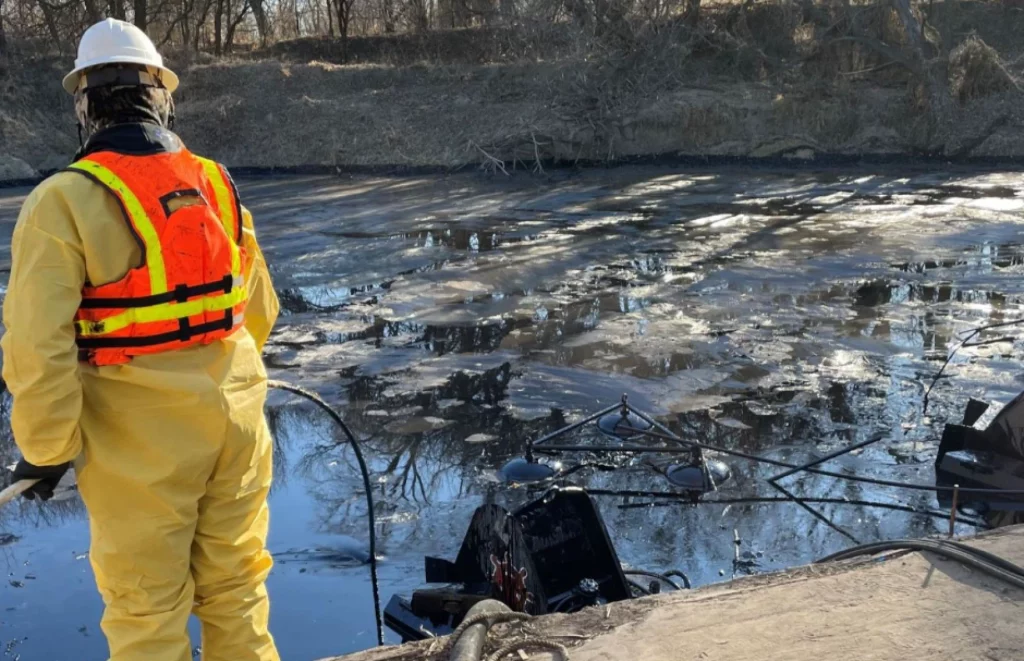Washington, KS- Crude oil began flowing through the Keystone pipeline from Nebraska through Kansas to Oklahoma again this week.
For now, the U.S. Department of Transportation requires the pipeline segment to operate at a lower pressure than when it burst. The pressure must stay 20% lower than when the Keystone’s biggest-ever spill happened on Dec. 7 in north-central Kansas.
The federal agency won’t disclose what the operating pressure was on Dec. 7. It told the Kansas News Service to file an open records request.
Canadian oil company TC Energy said it restored the Cushing Extension to service on Thursday. That segment of the Keystone system is critical to transporting oil from the Canadian tar sands in Alberta to facilities in the Midwest and as far as Houston, Texas.
“The Keystone Pipeline System is now operational to all delivery points,” the company said in a statement. “As always, we continue to monitor the system 24/7 as we deliver the energy customers and North Americans rely on.”
A Dec. 8 federal order required the eventual pipeline restart to ramp up gradually. That meant using “incremental pressure increases … with each increment to be held for at least 2 hours.”
TC Energy also had to give local landowners and emergency response crews advance notice, the order from the Department of Transportation’s Pipeline and Hazardous Materials Safety Administration said.
TC Energy won’t say what pressure level was in effect when the pipeline broke on Dec. 7. In 2017, the company received a federal greenlight to run sections of the Keystone at a higher pressure than is typically allowed, because the pipeline would use stronger steel.
That permission included parts of the Cushing Extension that runs from Steele City, Nebraska., through Kansas, to Cushing, Oklahoma.
Neither TC Energy nor federal regulators have said if they’ve identified what likely caused the spill. The federal government required TC Energy to hire a third-party to help the company document what happened and complete an analysis within three months.
Read more about the Keystone spill in Kansas:
- Pipeline company says Kansas oil spill contained, but chemicals found downstream
- Not just any oil spill. The Keystone pipeline dumped notoriously hard-to-clean ‘dilbit’ in Kansas
- Keystone Pipeline has history of spills, warnings and fines. This Kansas spill is the largest yet
The oil cleanup continues. In its most recent update on the cleanup, the company said it had recovered about 7,600 barrels. It estimates that about 14,000 barrels (about 590,000 gallons) spilled.
The stuff that gushed out across several acres of farmland and into Mill Creek wasn’t conventional crude oil. It was diluted bitumen, also known as dilbit, and this poses extra challenges for environmental cleanup.
Normal methods for cleaning oil spills in water rely on the fact that the oil floats. But dilbit sinks — a process that can start within days and makes tracking the stuff tricky.
A National Academies of Sciences study found “there are no proven techniques for containment” of dilbit that has begun sinking in moving water.
TC Energy has said the oil spill is contained — with emergency dams and booms — to about four miles of Mill Creek, but Kansas environmental officials say benzene and other chemicals from the spill have shown up farther downstream.
The chemicals won’t affect public drinking water, the state says, because they will become too diluted by river water before reaching areas that supply drinking water. However, the state says the chemicals pose a risk to wildlife that consume them through the food chain.
Celia Llopis-Jepsen is the environment reporter for the Kansas News Service. You can follow her on Twitter @celia_LJ or email her at celia (at) kcur (dot) org.
The Kansas News Service is a collaboration of KCUR, Kansas Public Radio, KMUW and High Plains Public Radio focused on health, the social determinants of health and their connection to public policy.
Kansas News Service stories and photos may be republished by news media at no cost with proper attribution and a link to ksnewsservice.org.













